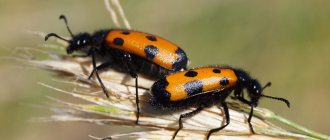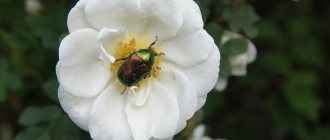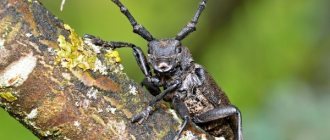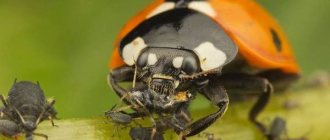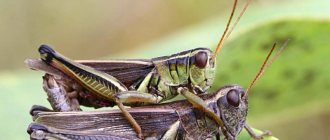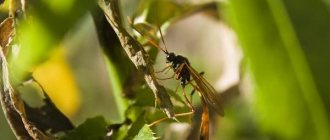The stag beetle is an arthropod insect from the order Coleoptera, suborder omnivorous beetles, superfamily Scarabaeidae, family stag beetles (Lucanidae - stag beetles, comb beetles, stag beetles).
The stag beetles received their Latin name from the name of the area of Lucania, located northeast of the famous Italian city of Pisa. Since ancient times, local residents have used stags to make amulets. The Russian name of the family comes from the visual similarity of the insect’s highly developed and protruding upper jaws with horns.
Origin of the species and description
Photo: Horn beetle
Horned beetles belong to the order Coleoptera, the family of stag beetles. The name of their genus in Latin sounds like Lucanus. These insects are famous for their unusual appearance and large dimensions. In nature, there were individuals whose length reached ninety millimeters! Stag beetles are also called stag beetles. This is due to their large growths located on the head. Outwardly, they resemble deer antlers.
Interesting fact: The stag beetle is considered the largest beetle in all of Europe. On the territory of Russia it is surpassed in size only by the relic woodcutter.
The Latin name Lucanus literally translates as “living in Lucania.” This is a small area in northern Etruria. It was there that the stag beetle first gained great popularity. The inhabitants of Lucania considered these insects sacred and made amulets from them. Over the course of many years, the name Lucanus was assigned to a whole genus of staghorns. These beetles were first called deer beetles in 1758. This name was given to them by Carl Linnaeus. Today both names are considered correct.
Video: Horn beetle
At the moment, the genus of insects has more than fifty species. Beetles are distributed almost throughout the globe. It is simply impossible not to recognize the stag beetle among the variety of other beetles. They are large, have a flattened body and enlarged mandibles (only in males; in females they are less pronounced).
Home care and maintenance
Such insects are born and spread not only naturally. People also breed these beetles with remarkable external characteristics artificially. First of all, this is done to restore the stag population.
Suitable conditions are created for their growth and development, and real pyramids are erected from oak rot. The basis of these “houses” are tree trunks driven into the forest soil. And in this favorable microclimate the beetles lay, the larvae of stag beetles develop and thrive.
Insect fans also breed beetles at home, which gives them the opportunity to observe the life of these creatures. Specialist breeders raise beautiful specimens of staghorns also for sale. This process is difficult and lengthy, requiring patience and the necessary knowledge. And this is how it goes.
Suitable containers are taken (no matter what material they are made of) and filled with sawdust. They contain the testicles of stag beetles. Now the main thing is to ensure that the humidity and temperature in this cage is close to natural.
Here, careful monitoring of the development of the larvae is necessary in order not only to ensure their proper formation, but also to protect them from parasites and fungal diseases. If everything is done correctly, then in five years a miracle will appear to the world - a domestic stag beetle , and perhaps more than one. These pets are fed sugar syrup, to which you can add juice or honey.
Appearance and features
Photo: Animal stag beetle
The stag beetle has extraordinary external characteristics:
- The average body size of males is from forty-five to eighty-five millimeters, females - from twenty-five to fifty-seven. The variation in values is due to the fact that beetles grow to different sizes in different places;
- Large, slightly flattened body. The body has dark brown, brown-black or reddish-brown elytra. They completely cover the belly. The lower body is painted black;
- The gender of this insect can be determined by the size of the mandibles. In males, the horns are well developed; they can even be longer than the entire body. Males have two teeth on each mandible. Females cannot boast of such “decoration”. Their mandibles are very small;
- The beetles have a wide head and geniculate antennae. In females, the eyes are solid, while in males they are separated by projections;
- In nature, there are adult stag beetles with bright body colors. They come in orange and green. Their body has a beautiful golden, metallic sheen.
Interesting fact: The color of the horns during life of beetles is bright brown with a pronounced red tint. But after death, the mandibles change. They become darker and acquire a dark brown tint.
Keeping rhinoceros beetles at home
It must be taken into account that in most cases, rhinoceros beetles, regardless of gender, show aggression towards their relatives, so it is recommended to keep the insects alone.
Most often, these beetles are kept in plastic containers with a lid. It is important to make small holes in the container to ensure good ventilation. Suitable fillers include turf soil, sphagnum moss, coconut substrate or dust from deciduous trees. It is recommended to periodically moisten the soil and rot. The litter needs to be changed when it gets dirty. The earth can be calcined and reused.
Since the nutrition of the rhinoceros beetle has not yet been studied, the opinions of breeders on this matter differ. Some people believe that the insect does not need to be fed. Others point out that the beetles need to be given ripe fruit daily. It is important to remember that any food should be removed no more than after 24 hours, otherwise midges may appear in the container. There is no need to place a container with water, since the beetle gets all the necessary liquid from fruits and a moistened substrate.
Where does the stag beetle live?
Photo: Insect stag beetle
Rogach lives in Turkey, Russia, Kazakhstan, Iran, Western Asia, Europe, and a small number is found in North Africa. The natural habitat also includes countries such as Moldova, Georgia, Latvia, Belarus, and Ukraine. In Europe, beetles have settled in the territory from Sweden to the Balkan Peninsula. Previously, stags lived in Lithuania, Estonia, Denmark and even Great Britain. But today they are considered an extinct species in these countries.
Interesting fact: In Russia, the stag beetle is one of three species of the genus Lucanus. In Belarus and Ukraine this species is the only representative.
For living, stag beetles choose a temperate climate. Climate zones that are too hot or too cold are not suitable for them. In order for a new colony of stag beetles to appear on the territory, certain conditions are necessary - the presence of a large number of fallen trees and stumps. It is in them that the insect lays larvae.
It is difficult to name specific wood species in which stags prefer to live. Beetles and their offspring were often found near various stumps and fallen tropical trees. For these animals, the decisive factor is rather another point - the age of the wood. They prefer to live in wood that is in a state of deep decomposition.
Beetles and cultural life
In the Middle Ages, it was believed that if you carried the head of a horned beetle with you, it would help protect children from all kinds of diseases, and adults from seizures. Nowadays, some people use them as costume accessories. The beetle's ashes were used as an aphrodisiac or diuretic.
The memorable appearance and mythological image of the insect very often prompted painters to create masterpieces. For example, Italian Renaissance artists depicted beetles in their paintings.
During the era of silent films, the stag beetle was the main character in documentaries and feature films. For example, in Russia, the first animated film was dedicated to the distinctive features of male beetles fighting for the attention of a female. It was at that time that time-lapse technology was first used. Subsequently, many more directors made films in similar themes, mainly due to the similarity of the image with knightly duels in the Middle Ages.
Nowadays, the image of the horned beetle can be seen on tableware paintings, banknotes and coins of certain European countries, as well as on postage stamps.
What does the stag beetle eat?
Photo: Horn beetle Red Book
The daily menu of stag beetles is not very diverse. The diet of such an animal directly depends on its habitat and stage of development. The larvae mainly eat rotten bark and wood. They have an impressive size and excellent appetite. Even one larva is capable of gnawing through an entire system of tunnels in the bark of a tree in a short time. It is at the larval stage that the bulk of food is absorbed.
Adults need plant sap to maintain vitality. They drink the sap of trees, green spaces, and bushes. This juice is quite nutritious. To obtain it, beetles sometimes have to work hard - gnawing out the bark. This is what mostly female stags do. If there is no juice nearby, the stag beetle can feast on sweet nectar, ordinary water (morning dew).
Interesting fact: Stalkers often have real “knightly” fights over the source of tree sap. Males fight fiercely with powerful horns. The winner gets fresh, nutritious juice.
A typical meal for stag beetles takes several hours. They need a lot of juice to maintain vitality. Recently, such animals are often caught for domestic keeping. At home, the stag's diet consists of: fresh grass, sugar syrup, juice, honey.
Diet
When researching what the horn beetle eats, it turned out that it gets enough plant juice. He takes it from places where plant bark is damaged. It is extremely rare that insects damage young shoots to extract juice.
During the process of long-term development, the larva accumulates so many nutrients that the supply of the adult beetle is enough for the entire active period of life. Since there is no need to be distracted by searching for food, he is entirely occupied with solving the problem of procreation.
The horned beetle is listed in the Red Book, as the number of the species is constantly declining. This is facilitated by cutting down and treating forests with pesticides, as well as clearing them of rotten wood. Birds that hunt staghorns and collectors contribute to the decline in numbers.
Features of character and lifestyle
Photo: Horn beetle
As noted above, the size of stag beetles depends on the habitat. But it's not just size. The lifestyle of an insect is also directly dependent on the region in which it lives. In most of the natural range, the beetle's flight begins in May and ends in July. At the same time, in the north, the main activity occurs at night. During the day, beetles prefer to hide in trees. In the southern part, everything is exactly the opposite - beetles are active during the day and rest at night.
Adult males have a greater tendency to fly. Females fly much less often, out of necessity. During the day, stags travel short distances through the air - from one tree to another. However, they can move with the help of their wings for three kilometers. This type of insect is different in that they cannot always take off from a horizontal surface. This is due to the large size of the horns. To rise into the air, these bugs specially fall from tree branches.
The character of this insect is warlike. The stag often attacks other animals and enters into fights with representatives of its own species. The stag can also use its strength against predators and people. However, there is always an explanation for such aggressive behavior. The beetle can attack people, predators, and other insects only for the purpose of self-defense. The stag beetle fights with beetles of its own species for some goal - a female, a source of food.
Interesting fact: When fighting for tree sap or a female, stag beetles do not inflict fatal injuries on each other. The winner in the battle is the one who was able to knock his opponent to the ground.
From larva to pupa
Scientists have recognized the fact that the larvae call each other with chirping sounds that come from protrusions located in the insect's legs. Further transformation is a cocoon. It is made by larvae from wood dust and excrement. Then it is held together by the fluid of the salivary glands.
It takes 3 months for the pupa to develop. But even after turning into a beetle, the individual remains in the cocoon for some time. An interesting nuance is that the male larva prepares a large cocoon for itself so that future horns can fit into it.
Unfortunately, the overall numbers of stag beetles and rhinoceroses are falling. The reason for this is environmental factors, due to which the habitat of insects is modified and reproduction declines. The Red Book and human consciousness are the only measure to preserve unusual species.
We recommend checking out: https://fb.ru
Social structure and reproduction
Photo: Horn beetle insect
The process of procreation in the stag beetle has some features:
- The breeding season lasts two months: from May to June. Males look for females at dusk; to attract the chosen “lady” I can dance demonstratively and show off my big horns;
- Direct mating in these insects takes several hours. The whole process usually takes place on a tree;
- At one time, a male staghorn can lay up to twenty eggs. Previously, scientists greatly overestimated the animal’s capabilities, believing that the female lays about a hundred eggs;
- The eggs develop over several weeks - from three to six. They have a characteristic yellow color and oval shape. Then they degenerate into larvae;
- The larval stage is the longest. It takes more than five years. During this time, the larva can eat a huge amount of wood, as it has a good appetite. Larval development usually occurs in the underground part of the tree or in stumps;
- Females lay eggs preferentially in oak trees. However, oaks are not the only suitable type of tree. Larvae were found in various stumps and trunks. They feed on rotten wood and help natural materials decompose faster;
- The larvae turn into pupa in October.
Habitat and lifestyle
Most of the variety of rhinoceros beetles lives in the Afrotropical region, that is, south of the African Sahara Desert. In general, a beetle with a horn on its head lives in all parts of the world where deciduous trees grow. The exception is the northernmost territories: tundra, taiga, Arctic.
For information! With the development and settlement of territories in the north and northeast of Europe by people, the habitat of the rhinoceros beetle has expanded significantly, and the beetle itself has become synanthropic - associated with human life and activity.
Natural enemies of stag beetles
Photo: Animal stag beetle
The stag beetle is an easy prey for large birds. They are hunted by crows, hooded crows, black crows, magpies, owls, hobby hobbies, rollers, and many other representatives of corvids. Birds prefer to feast only on the belly of the animal. They throw away the remains of the beetle. However, many scientists claim that there are birds that swallow staghorns whole. For example, eagle owls. A huge number of beetles die every year from the paws of birds. In forests where such insects live in large numbers, you can easily find the remains of horns, bodies, and heads.
Also, jays, woodpeckers, rooks and even bats will not refuse to dine on stags. Less commonly, such insects become victims of domestic cats, ants, and ticks. Wasps from the genus Scolia can be classified as natural enemies. Large representatives of this genus attack exclusively larvae. They paralyze them and lay their eggs in their torso. The hatched wasp larvae then eat the stag beetle larva. Wasp larvae begin their meal with the most important and nutritious vital organs.
Humans can also be called a natural enemy of the stag beetle. People catch adults for their own amusement, profit, or just out of curiosity. Many people try to keep them at home, which leads to the death of the animals. Others sell beetles to collectors for huge sums.
Threats
Among the main threats that pose a danger to insects are the following:
- elimination of dry trees where insect larvae live;
- The Scolia wasp immobilizes the beetle larvae with a sting and lays its eggs in them;
- eagle owl, magpie and other birds hunt insects and use them for food;
- replenishment of collection specimens of insects significantly reduces the number of individuals of this species.
Even in the sources of Ancient Greece, there were initial references to this type of insect. Already in those days, the stag beetle was considered an inspiration among poets and playwrights, in addition, it was the main character of various legends. In ancient times, people believed in the supernatural powers of insects; for example, in Ancient Greece and Rome, their heads were worn around the neck as a talisman against unclean spirits.
Population and species status
Photo: Horn beetle
Today, the beetle population throughout its natural habitat is gradually declining. Horn beetles began to be found even in oak forests very rarely, locally. Scientists suggest that in the near future this insect will face complete extinction. These beetles maintain high numbers only in certain areas. For example, in the Kharkov and Chernigov regions of Ukraine. There, from time to time, outbreaks of an increase in the number of these animals are still observed.
What influences the population of this species so much?
The following factors influence the decline in the number of staghorns:
- Ecological. Widespread deterioration of the environmental situation, pollution of soil, water, air - all this negatively affects the survival of animals in the wild;
- Irresponsible human activities in forests. Horn beetles settle near forests where there are stumps and fallen tree trunks. Uncontrolled logging, destruction of wood - all this leads to a reduction in the number of stag beetles. The beetles simply have no place to lay their eggs;
- Illegal trapping of insects by people. The stag beetle is a tasty morsel for any collector. On the market, the cost of such an insect sometimes exceeds one thousand dollars, depending on the size and color of the animal.
Life cycle of stag beetles
Life cycle of stag beetles.
Before an adult stag beetle is born, it has a very long journey to go, which can take from 4 to 8 years. At the same time, its life expectancy at the imago stage is most often only 2-3 weeks.
For successful mating, stags need several hours, but before that, the male still has to compete for the female. The confrontation between competitors takes place with the help of huge mandibles and its goal is not to kill, but simply to knock the enemy onto his back.
Eggs
Stag beetle eggs.
After the winner is determined and successful mating has occurred, the female lays two dozen eggs. In order to provide future larvae with food supply, she arranges a separate chamber for each egg in decaying wood. Most often, the female does this inside rotten trunks, stumps or hollows.
The eggs of beetles of this family are quite large, pale yellow, and oval-shaped. Their diameter can reach 2-3 mm. The emergence of the formed larva from the egg, according to various sources, occurs in approximately 3-6 weeks.
Larva
The body of the larva is painted white, and the head is contrasting brown-orange or yellow-red. The larva's jaws are very well developed, which allows it to easily cope with its favorite delicacy - rotten wood.
Stag beetle larva.
The limbs of the larva are also quite developed and have approximately the same structure and length. There are teeth on the thighs of the middle pair of legs, and on the trochanters of the rear pair there is a special protrusion. Together, these parts of the larvae’s body form a stridulation organ, which allows them to make special sounds. With the help of these sounds, the larvae can communicate with each other.
The diet of future beetles consists exclusively of decaying wood, on which mold has already appeared. These insects never touch healthy branches and trunks of trees. Most often, staghorn larvae can be found inside the decaying roots or trunks of such trees:
- oak;
- beech;
- elm;
- birch;
- willow;
- hazel;
- ash;
- poplar;
- Linden.
On average, an insect spends about 5-6 years at the larval stage, depending on the climate. For example, development can be significantly inhibited by severe frosts or prolonged drought. Before the larva pupates, its body length can already reach 10-13.5 cm, and its diameter can be about 2 cm.
At the same time, the weight of such a larva can be as much as 20-30 grams.
Doll
Stag beetle pupa.
The pupation process begins in mid-autumn. To do this, the larva prepares a special chamber for itself in advance - a cradle. To create a “cradle” the insect uses wood shavings, soil and its own excrement.
Such a chamber is placed in the upper layers of the soil at a depth of 15 to 40 cm. The length of the stag pupa can reach 4-5 cm. An adult usually emerges from the cocoon around late spring - early summer.
